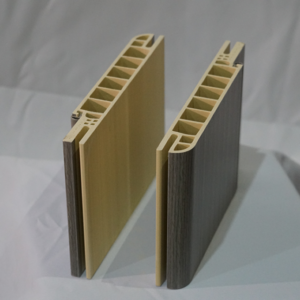Wood plastic composite (WPC) doors have gained popularity for their numerous advantages, offering a blend of wood-like aesthetics with the stability and durability of resin products. Let’s delve into the characteristics, advantages, and drawbacks of WPC doors:

The WPC Doors Advantages:
- Durability: WPC resin is highly durable, with a lifespan ranging from 25 to 50 years, ensuring long-lasting performance.
- Aesthetics and Stability: WPC doors boast the appearance and texture of wood while possessing the stability, waterproofing, and insect-resistant properties of resin products. They exhibit excellent dimensional stability compared to wood.
- Thermal Insulation and Sound Dampening: WPC doors offer low thermal conductivity, providing effective insulation and sound dampening properties, enhancing comfort and tranquility indoors.
- Crack and Warp Resistance: Unlike wood, WPC doors do not crack, warp, or exhibit wood knots or diagonal grains, ensuring a uniform appearance over time.
- Ease of Secondary Processing: WPC doors can undergo secondary processing such as sawing, planing, bonding, and fastening with nails or screws, offering flexibility in customization.
- Flame Retardancy: WPC resin doors exhibit excellent flame retardant properties, minimizing the risk of combustion and extinguishing automatically when removed from the heat source.
- Versatile Surface Treatments: With various surface treatment options such as laminating or painting, WPC doors can be embellished with carvings, molding, or decorative lines, catering to diverse aesthetic preferences while maintaining stability and longevity.
- Quick Installation: Equipped with a fast assembly structure, WPC doors feature German-imported quick assembly systems with metal connectors, ensuring convenient and efficient installation without the need for nails or adhesives.

The WPC Doors Disadvantages:
- Susceptibility to High Temperatures: WPC doors are less heat-resistant compared to wood, softening when exposed to high temperatures.
- Dimensional Limitations: Due to mold width constraints, there are limitations on the width dimensions of WPC doors, and carving depth must be controlled within 2mm due to fixed product wall thickness.
Characteristics of WPC Doors:
Wood plastic composite doors, made by mixing wood fine powder with polymer resin and extruding them through molds, combine the best qualities of wood and plastic. The primary raw materials include medical-grade PVC resin powder, ultra-fine wood powder, and eco-friendly rock powder, offering a green and environmentally friendly alternative to traditional wood.
WPC doors feature corrosion resistance, deformation resistance, waterproofing, thermal insulation, soundproofing, B1 flame retardancy, insect and termite resistance, and zero formaldehyde emissions, making them the preferred choice for residential, commercial, and institutional projects.


By understanding the unique properties and characteristics of WPC doors, consumers can make informed decisions when selecting doors for their spaces, balancing aesthetics, performance, and environmental considerations. Choose WPC doors for a blend of beauty, durability, and sustainability in your projects!







一个回复
I am really inspired together with your writing abilities and also with the format for your blog. Is this a paid topic or did you modify it yourself? Anyway stay up the nice quality writing, it is rare to look a great blog like this one these days!